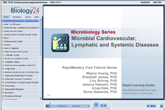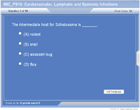| How to Learn in 24 Hours? |
|
| Need Help? |
M-F: 9am-5pm(PST):
Toll-Free: (877) RAPID-10
or 1-877-727-4310
24/7 Online Technical Support:
The Rapid Support Center
vip@rapidlearningcenter.com
Secure Online Order:

|
| Tell-A-Friend: |
Have friends taking science and math courses too? Tell them about our rapid learning system.
|
|
Cardiovascular, Lymphatic and Systemic Infections
| Topic Review on "Title": |
Blood Structure
- Blood consists of several different types of cells.
- Red blood cells are also called erythrocytes.
- The cells are suspended in plasma.
- Red blood cells carry oxygen.
- White blood cells are also called leukocytes and are used to fight disease.
- Platelets are involved in blood clotting.
Cardiovascular System
- The heart is a muscle that acts like a pump.
- Consists of a closed system where blood is pumped by the heart.
- The heart pumps blood into arteries, veins carry blood back to the heart.
- The major arteries are the pulmonary arteries which carry blood to the lungs and the aorta that take the blood to the remaining parts of the body.
- The major veins are: pulmonary veins which carry blood from the lungs to the heart, superior vena cava head neck and arms to heart and inferior vena cava from the rest of the body to the heart.
- The heart itself is supplied by coronary arteries which come from the aorta and cardiac veins which drain into the left atrium.
Human Heart
- The human heart is a muscle with four chambers.
- The heart is enclosed in a pericardial sac that is lined with a serous membrane. The pericardial sac is an important target for infection or inflammation by microbes.
- The wall of the heart is made up of an outer, fibrous pericardium, muscular myocardium and inner endocardium.
- Chambers of the Heart: The internal cavity of the heart is divided into four chambers: right & left atrium, right & left ventricle.
- The right atrium receives deoxygenated blood from systemic veins; the left atrium receives oxygenated blood from the pulmonary veins.
- The valves of the heart are another target for microbial infection. The valves keep the fluid flowing in one direction.
- The heart acts like two pumps, one on the right and one on the left.
- Blood goes from the right atrium to the right ventricle, and then is pumped to the lungs where it is oxygenated.
- From the lungs the blood goes to the left atrium and then to the left ventricle. From there it is pumped to the body for systemic circulation.
Lymphatic System
- The lymphatic system is a network of lymphoid organs, lymph nodes, ducts, tissues, vessels and fluid.
- The lymphatic system is an important component of the immune system.
- There are three functions of the lymphatic system: removes excess fluid from body tissues, absorbs fatty acids and takes them to the circulatory system and finally make immune cells such as lymphocytes, monocytes and antibody producing cells called plasma cells.
- The lymphatic system is made up of thin vessels that branch throughout the body similar to the blood system. The vessels carry a clear liquid called “lymph”. Blood plasma leaks from the capillaries of the blood circulatory system and fill the spaces between the cells of tissue, this is called interstitial fluid. The fluid accumulates slowly and is similar to the blood plasma. Most is returned to the circulatory system via the capillaries. Lymph has a large number of white blood cells. The remaining fluid, about 10% is collected as lymph (or lymphatic fluid which is colorless) by the lymphatic system. It is processed by the lymph nodes before it returns to the circulatory system.
- Lymph nodes are bean shaped and function as filters. They are filled with lymphocytes (white blood cells) which increase rapidly when fighting an infection.
- Pathogens and toxins that target vulnerabilities of the cardiovascular and lymphatic systems can spread throughout the body to cause what is referred to as systemic diseases. Several different pathogens are profiled that demonstrate these concepts.
|
| Rapid Study Kit for "Title": |
| Flash Movie |
Flash Game |
Flash Card |
| Core Concept Tutorial |
Problem Solving Drill |
Review Cheat Sheet |
 |
 |
 |
|
| "Title" Tutorial Summary : |
The structure and function of the cardiovascular and lymphatic systems are introduced. Infections of both systems are described and how infections involving these systems can lead to what is referred to as systemic infections. Systemic infections are those that spread beyond a specific organ system like digestive, respiratory etc. Systemic infections have spread throughout the body.
|
| Tutorial Features: |
Specific Tutorial Features:
- Detailed description of and graphical representation of the cardiovascular system.
- Detailed description and graphical representation of the lymphatic system.
- The structure of blood is presented in an animated step by step process.
Series Features:
- Concept map showing inter-connections of new concepts in this tutorial and those previously introduced.
- Definition slides introduce terms as they are needed.
- Visual representation of concepts
- Animated examples—of concepts are used to step wise breakdown a concepts.
- A concise summary is given at the conclusion of the tutorial.
|
| "Title" Topic List: |
Basic structure and function of the cardiovascular system.
Basic structure and function of the lymphatic system.
How the structures of the cardiovascular and lymphatic system are affected by microbial diseases.
Bacterial cardiovascular and systemic diseases.
Viral cardiovascular and systemic diseases.
Cardiovascular and systemic diseases caused by protozoans and helminthic organisms.
|
See all 24 lessons in Anatomy and Physiology, including concept tutorials, problem drills and cheat sheets:
Teach Yourself Microbiology Visually in 24 Hours
|



